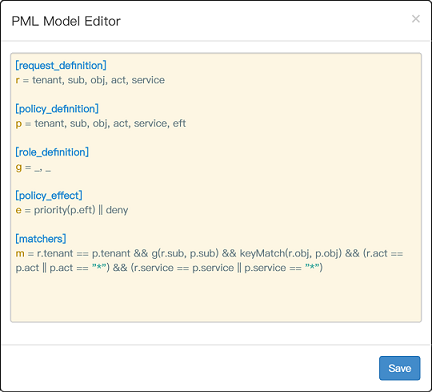同步操作将从 Casbin/pycasbin 强制同步,此操作会覆盖自 Fork 仓库以来所做的任何修改,且无法恢复!!!
确定后同步将在后台操作,完成时将刷新页面,请耐心等待。
News: still worry about how to write the correct Casbin policy? Casbin online editor is coming to help! Try it at: http://casbin.org/editor/
Casbin is a powerful and efficient open-source access control library for Golang projects. It provides support for enforcing authorization based on various access control models.
 |
 |
 |
 |
|---|---|---|---|
| Casbin | jCasbin | node-Casbin | PHP-Casbin |
| production-ready | production-ready | production-ready | production-ready |
 |
 |
 |
 |
|---|---|---|---|
| PyCasbin | Casbin4D | Casbin-Net | Casbin-RS |
| production-ready | experimental | WIP | WIP |
write-article, read-log. It doesn't control the access to a specific article or log.resource.Owner can be used to get the attribute for a resource./res/*, /res/:id and HTTP methods like GET, POST, PUT, DELETE.In Casbin, an access control model is abstracted into a CONF file based on the PERM metamodel (Policy, Effect, Request, Matchers). So switching or upgrading the authorization mechanism for a project is just as simple as modifying a configuration. You can customize your own access control model by combining the available models. For example, you can get RBAC roles and ABAC attributes together inside one model and share one set of policy rules.
The most basic and simplest model in Casbin is ACL. ACL's model CONF is:
# Request definition
[request_definition]
r = sub, obj, act
# Policy definition
[policy_definition]
p = sub, obj, act
# Policy effect
[policy_effect]
e = some(where (p.eft == allow))
# Matchers
[matchers]
m = r.sub == p.sub && r.obj == p.obj && r.act == p.act
An example policy for ACL model is like:
p, alice, data1, read
p, bob, data2, write
It means:
We also support multi-line mode by appending '\' in the end:
# Matchers
[matchers]
m = r.sub == p.sub && r.obj == p.obj \
&& r.act == p.act
Further more, if you are using ABAC, you can try operator in like following in Casbin golang edition (jCasbin and Node-Casbin are not supported yet):
# Matchers
[matchers]
m = r.obj == p.obj && r.act == p.act || r.obj in ('data2', 'data3')
But you SHOULD make sure that the length of the array is MORE than 1, otherwise there will cause it to panic.
For more operators, you may take a look at govaluate
What Casbin does:
{subject, object, action} form or a customized form as you defined, both allow and deny authorizations are supported.root or administrator. A superuser can do anything without explict permissions.keyMatch can map a resource key /foo/bar to the pattern /foo*.What Casbin does NOT do:
username and password when a user logs in)pip install casbin
https://casbin.org/docs/en/overview
You can also use the online editor (http://casbin.org/editor/) to write your Casbin model and policy in your web browser. It provides functionality such as syntax highlighting and code completion, just like an IDE for a programming language.
https://casbin.org/docs/en/tutorials
import casbin
e = casbin.Enforcer("path/to/model.conf", "path/to/policy.csv")
Note: you can also initialize an enforcer with policy in DB instead of file, see Persistence section for details.
sub = "alice" # the user that wants to access a resource.
obj = "data1" # the resource that is going to be accessed.
act = "read" # the operation that the user performs on the resource.
if e.enforce(sub, obj, act):
# permit alice to read data1
pass
else:
# deny the request, show an error
pass
roles = e.get_roles("alice")
See Policy management APIs for more usage.
tests files for more usage.Casbin provides two sets of APIs to manage permissions:
We also provide a web-based UI for model management and policy management:


In Casbin, the policy storage is implemented as an adapter (aka middleware for Casbin). To keep light-weight, we don't put adapter code in the main library (except the default file adapter). A complete list of Casbin adapters is provided as below. Any 3rd-party contribution on a new adapter is welcomed, please inform us and I will put it in this list:)
| Adapter | Type | Author | Description |
|---|---|---|---|
| File Adapter (built-in) | File | Casbin | Persistence for .CSV (Comma-Separated Values) files |
| Filtered File Adapter (built-in) | File | @faceless-saint | Persistence for .CSV (Comma-Separated Values) files with policy subset loading support |
For details of adapters, please refer to the documentation: https://casbin.org/docs/en/policy-storage
Some adapters support filtered policy management. This means that the policy loaded by Casbin is a subset of the policy in storage based on a given filter. This allows for efficient policy enforcement in large, multi-tenant environments when parsing the entire policy becomes a performance bottleneck.
To use filtered policies with a supported adapter, simply call the LoadFilteredPolicy method. The valid format for the filter parameter depends on the adapter used. To prevent accidental data loss, the SavePolicy method is disabled when a filtered policy is loaded.
We support to use distributed messaging systems like etcd to keep consistence between multiple Casbin enforcer instances. So our users can concurrently use multiple Casbin enforcers to handle large number of permission checking requests.
Similar to policy storage adapters, we don't put watcher code in the main library. Any support for a new messaging system should be implemented as a watcher. A complete list of Casbin watchers is provided as below. Any 3rd-party contribution on a new watcher is welcomed, please inform us and I will put it in this list:)
| Watcher | Type | Author | Description |
|---|
The role manager is used to manage the RBAC role hierarchy (user-role mapping) in Casbin. A role manager can retrieve the role data from Casbin policy rules or external sources such as LDAP, Okta, Auth0, Azure AD, etc. We support different implementations of a role manager. To keep light-weight, we don't put role manager code in the main library (except the default role manager). A complete list of Casbin role managers is provided as below. Any 3rd-party contribution on a new role manager is welcomed, please inform us and I will put it in this list:)
| Role manager | Author | Description |
|---|---|---|
| Default Role Manager (built-in) | Casbin | Supports role hierarchy stored in Casbin policy |
For developers: all role managers must implement the RoleManager interface.
If you use Casbin in a multi-threading manner, you can use the synchronized wrapper of the Casbin enforcer: https://github.com/casbin/casbin/blob/master/enforcer_synced.go.
It also supports the AutoLoad feature, which means the Casbin enforcer will automatically load the latest policy rules from DB if it has changed. Call StartAutoLoadPolicy() to start automatically loading policy periodically and call StopAutoLoadPolicy() to stop it.
The overhead of policy enforcement is benchmarked in model_b_test.go. The testbed is:
Intel(R) Core(TM) i7-6700HQ CPU @ 2.60GHz, 2601 Mhz, 4 Core(s), 8 Logical Processor(s)
The benchmarking result of go test -bench=. -benchmem is as follows (op = an Enforce() call, ms = millisecond, KB = kilo bytes):
| Test case | Size | Time overhead | Memory overhead |
|---|---|---|---|
| ACL | 2 rules (2 users) | 0.015493 ms/op | 5.649 KB |
| RBAC | 5 rules (2 users, 1 role) | 0.021738 ms/op | 7.522 KB |
| RBAC (small) | 1100 rules (1000 users, 100 roles) | 0.164309 ms/op | 80.620 KB |
| RBAC (medium) | 11000 rules (10000 users, 1000 roles) | 2.258262 ms/op | 765.152 KB |
| RBAC (large) | 110000 rules (100000 users, 10000 roles) | 23.916776 ms/op | 7.606 MB |
| RBAC with resource roles | 6 rules (2 users, 2 roles) | 0.021146 ms/op | 7.906 KB |
| RBAC with domains/tenants | 6 rules (2 users, 1 role, 2 domains) | 0.032696 ms/op | 10.755 KB |
| ABAC | 0 rule (0 user) | 0.007510 ms/op | 2.328 KB |
| RESTful | 5 rules (3 users) | 0.045398 ms/op | 91.774 KB |
| Deny-override | 6 rules (2 users, 1 role) | 0.023281 ms/op | 8.370 KB |
| Priority | 9 rules (2 users, 2 roles) | 0.016389 ms/op | 5.313 KB |
| Model | Model file | Policy file |
|---|---|---|
| ACL | basic_model.conf | basic_policy.csv |
| ACL with superuser | basic_model_with_root.conf | basic_policy.csv |
| ACL without users | basic_model_without_users.conf | basic_policy_without_users.csv |
| ACL without resources | basic_model_without_resources.conf | basic_policy_without_resources.csv |
| RBAC | rbac_model.conf | rbac_policy.csv |
| RBAC with resource roles | rbac_model_with_resource_roles.conf | rbac_policy_with_resource_roles.csv |
| RBAC with domains/tenants | rbac_model_with_domains.conf | rbac_policy_with_domains.csv |
| ABAC | abac_model.conf | N/A |
| RESTful | keymatch_model.conf | keymatch_policy.csv |
| Deny-override | rbac_model_with_deny.conf | rbac_policy_with_deny.csv |
| Priority | priority_model.conf | priority_policy.csv |
Casbin as a Service solution based on gRPC, both Management API and RBAC API are provided....
This project is licensed under the Apache 2.0 license.
If you have any issues or feature requests, please contact us. PR is welcomed.
此处可能存在不合适展示的内容,页面不予展示。您可通过相关编辑功能自查并修改。
如您确认内容无涉及 不当用语 / 纯广告导流 / 暴力 / 低俗色情 / 侵权 / 盗版 / 虚假 / 无价值内容或违法国家有关法律法规的内容,可点击提交进行申诉,我们将尽快为您处理。